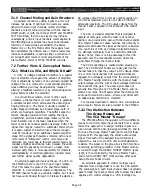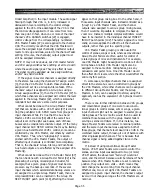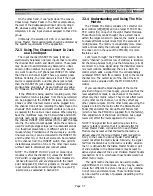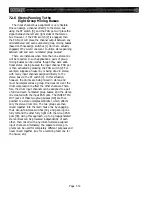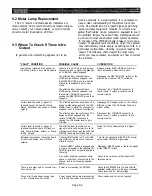
With eight auxiliary sends, and four aux returns, it’s
easy to utilize the most sophisticated effects. The aux
returns, which can each be used for a mono or stereo
source, have two-band, sweep-frequency equalization. If
even more returns are needed, input channels may be
used (they each have four-band parametric equalization
with plenty of overlap between bands). Built-in talkback
capability make it easier for the producer or director to
speak with crew or talent.
8.1.5 Sound Reinforcement
The PM4000’s electronically balanced inputs are of
the highest quality [and input transformers can be
installed internally where the extra isolation is required
??]. Input channel sensitivity is now broadly adjustable
from -90 dBu to +4 dBu by means of a 30 dB attenua-
tion pad plus a Gain trim control with 50 dB range, so
fader mix settings can uniformly aligned for faster
visual confirmation of the nominal position; there’s
plenty of gain when it’s needed, and noise is minimized
when the extra gain is not needed. Four band paramet-
ric equalization, plus a sweep-frequency high pass filter,
facilitate broad tonal adjustments or pinpoint correc-
tions.
Eight group busses can be used to sub-mix various
vocal and/or instrumental sections, and these can be
remixed to mono or stereo for the house feed by means
of either the stereo bus, or the 11x8 Mix Matrix. If the
Mix Matrix is used to feed the house, then the stereo
bus can perform as two additional group busses. With
another eight auxiliary busses, each switchable for pre
or post input fader pick-off, there is no shortage of
effects sends or foldback (monitor) sends. The console’s
standard configuration provides at least four stereo
input modules, any or all of which can be used for
auxiliary returns (internal jumpers can be adjusted to
prevent potential feedback from inadvertent output-to-
input assignment looping). Eight VCA Masters provide
another means to deal with groups of inputs; use the
conventional groups where it is necessary to insert a
signal processor in the group signal path, or use the
VCAs where it is necessary to affect all the outputs from
a given input channel. Scene changes can be handled
with the VCA groups, or with the eight Master Mute
groups, that, with the press of a Master Mute switch,
turn on or off assigned groups of input channels.
The PM4000 has other useful features for sound
reinforcement, such as: numerous LEDs to display
switch status and signal levels with far more reliability
than conventional lamps; an all aluminum chassis with
aircraft-style ribs and braces that affords low weight
and high strength; a low profile that blocks fewer seats
in the house while providing a good sight line to the
stage; an extensive input-priority “in place” cue system,
plus a solo mode that mutes other channels for faster
setup and faster troubleshooting during sound checks.
8.2 Setup Concepts
8.2.1 Deriving A Stereo Mix From
Groups 1-8.
There are a number of ways to obtain a stereo mix
with this console. One technique is to utilize Groups 1-8
for subgrouping input channels. The post Group Master
Fader [49] signals then can be assigned to the stereo
mixing bus using the GROUP-TO-ST switches [40] and
the Group PAN controls [39]. The Stereo Master Faders
[58] then become the overall stereo output control for
the mixed groups. In this setup, the input channel
direct-to-STereo assign switches [3] would not normally
be utilized, except on those input channels which may
be used for effects returns (in lieu of the aux returns).
This is a very straightforward means of achieving a
stereo mix (or dual mono output mixes) with subgroup
control, and without using the mix matrix or VCA
system.
Figure 8-1. System Diagram With Groups 1-8 as
Submasters, and Main Feed From Stereo Masters
Page 8-3
Summary of Contents for PM4000
Page 1: ...PROFESSIONAL AUDIO MIXING CONSOLE PM4000 OPERATING MANUAL YAMAHA ...
Page 2: ...PM4000 OPERATING MANUAL ...
Page 7: ...Section 1 Introduction ...
Page 11: ...Section 2 Brief Operating Instruction ...
Page 47: ...Section 3 Specifications ...
Page 51: ...Dimensional Drawings PM4000 Console all versions Page 3 4 ...
Page 52: ...Page 3 5 ...
Page 53: ...Page 3 6 PM4000 Console Rear Profiles ...
Page 54: ...Module Block Diagrams See back of the manual for overall system block diagram Page 3 7 ...
Page 55: ...Page 3 8 ...
Page 56: ...Page 3 9 ...
Page 57: ...Page 3 10 ...
Page 58: ...Page 3 11 ...
Page 59: ...Page 3 12 ...
Page 60: ...Section 4 Installation Notes ...
Page 72: ...Figure 4 13 Cables For Use With Balanced Sources Page 4 12 ...
Page 79: ...SECTION 5 Gain Structure and Levels ...
Page 82: ...Figure 5 1 Dynamic Range and Headroom in Sound Systems Page 5 3 ...
Page 86: ...Section 6 Optional Functions ...
Page 106: ...Section 7 Operating Notes and Hints ...
Page 119: ...Section 8 Applications ...
Page 127: ...Section 9 Maintenance ...
Page 131: ......
Page 132: ...YAMAHA VN02300 ...



